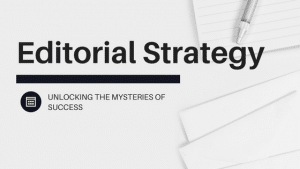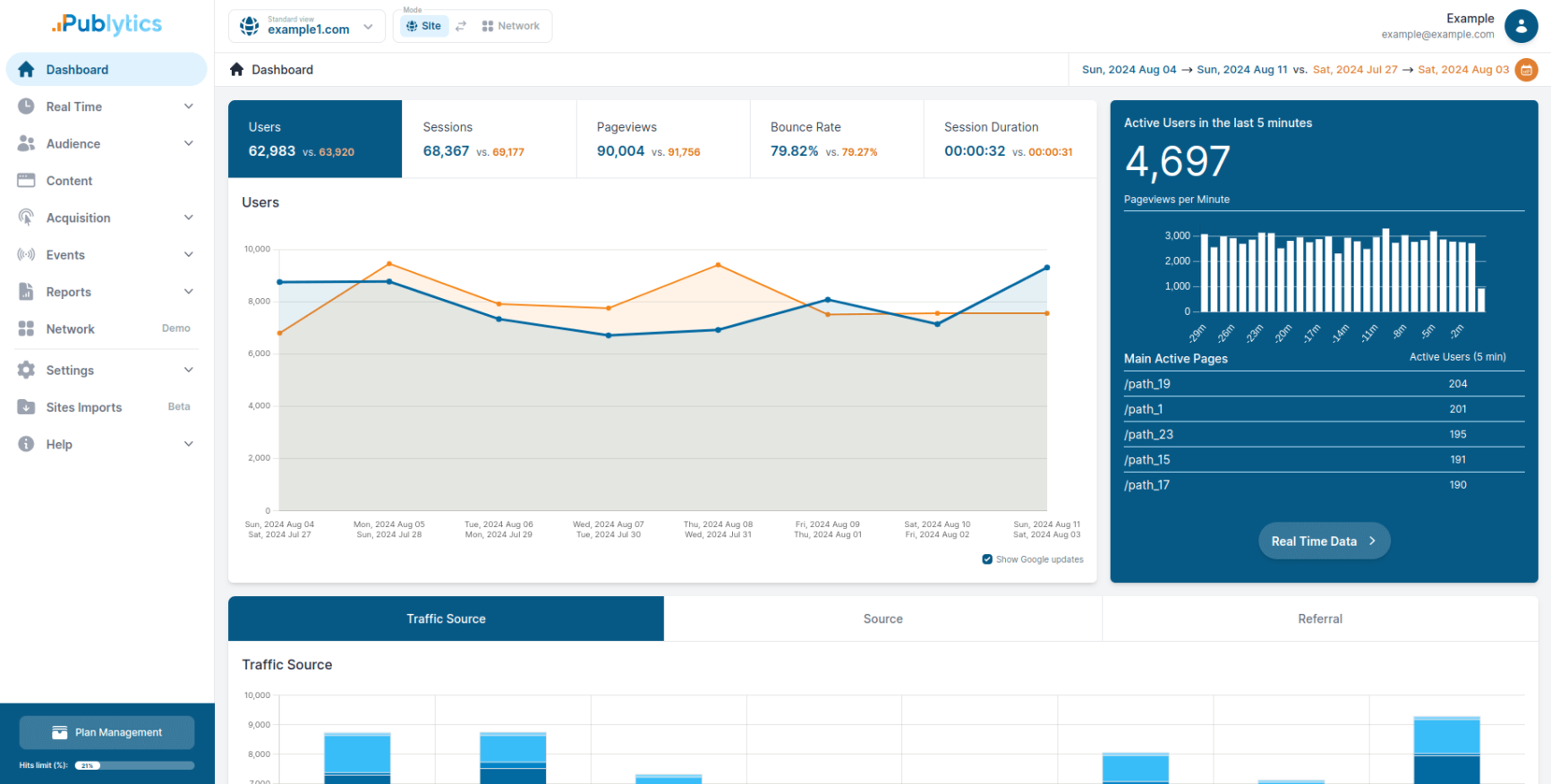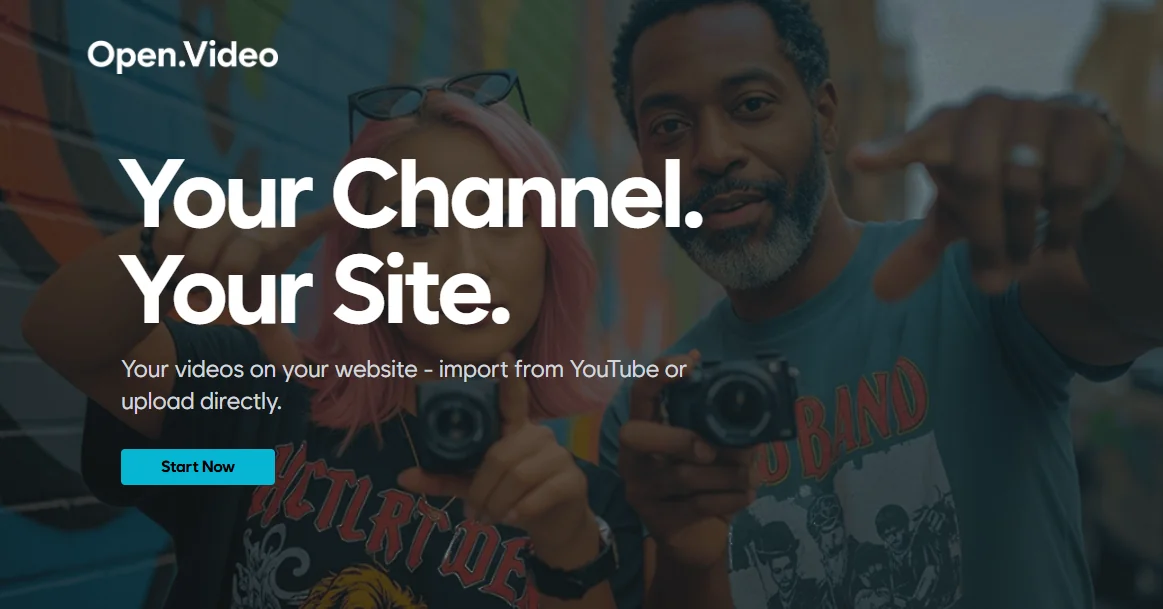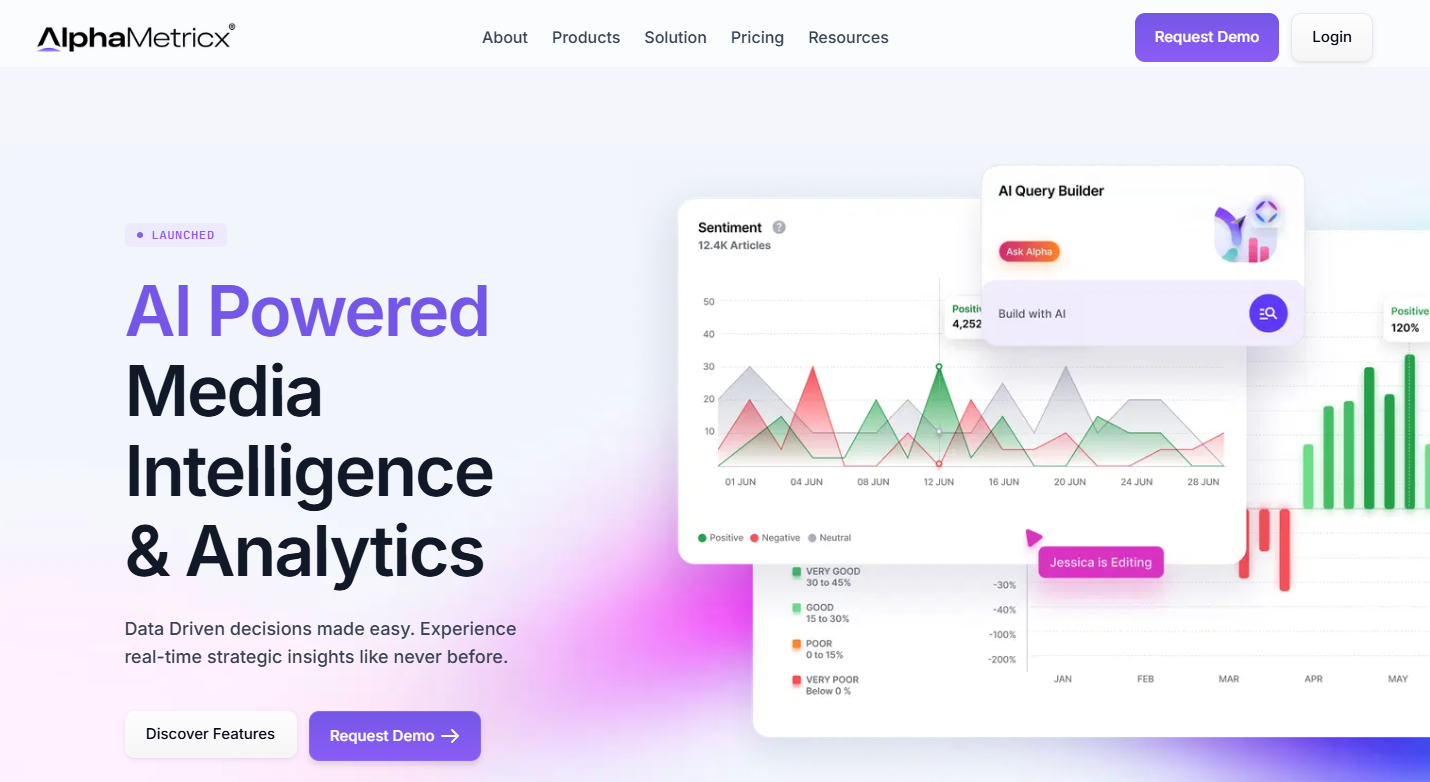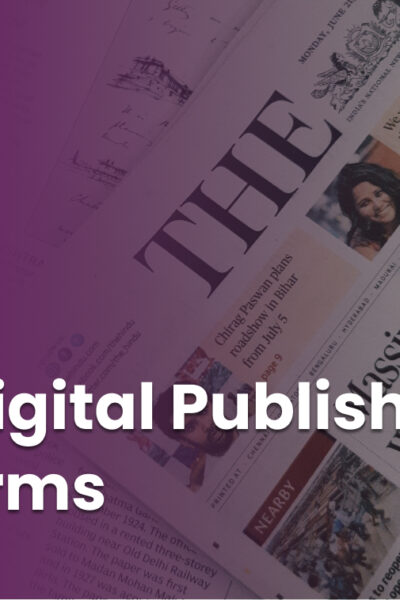Regardless of your place in the digital publishing landscape, you likely produce content to drive traffic, engage with an audience and spur conversions. It doesn’t matter if you want the reader to subscribe, come back for more, click an advertisement or buy a product: your online marketing strategy depends heavily on consistently publishing strong high-quality content. A content marketing approach requires that you have a foundational editorial strategy in place.
An editorial strategy is a roadmap for how you leverage various resources, tools, and content to meet your online business or digital publishing goals and serve the user’s needs. Journalist and digital publishing expert Christopher Wink says that editorial strategy is the “implementation of web-friendly content and interactivity on a platform.” That means that whether you’re publishing via social media, a blog, a news site or another format, you still need an editorial plan.
Wink also notes that a successful strategy helps you broaden partnerships, increase performance in search engines and drive more engagement with your audience. But you have to do that within the overall scope of content marketing, which means paying attention to user experience and following content strategy and content marketing best practices in addition to your editorial plans.
Start with a robust content strategy
Before you can define your editorial approach, you must understand what your overall content strategy is. The definitions, goals, and ideas that come out of creating a content strategy are what inform your editorial planning. Your business or organizational goals and the user’s needs, in turn, inform your content strategy.
You can create a basic content strategy in five steps once you have an organizational goal in mind. Some types of goals that you might start with include:
- To brand yourself, your company or your site as an expert in the niche
- To support professionals in the industry with high-level, informative content
- To increase traffic to your website with the goal of converting readers to customers
- To increase awareness of your product or service
- To build a loyal and engaged following (usually with the end goal of monetizing your site in some way)
Once you choose an overall big-picture goal, follow these five steps for creating a content strategy.
1. Define a target audience.
The audience is the most important element of any content strategy. Without an audience, your content is without purpose and your goals impossible. You can publish the most elaborate, high-quality blog posts, but if no one ever reads them, nothing else happens.
For the wrong audience, your content is confusing or useless, and it won’t drive engagement or conversions. For example, consider a website set up to publish news about medical device innovations. The site might offer a premium subscription service that provides in-depth analysis of thousands of medical devices on the market, but if it’s not attracting doctors, physical therapists and other providers with its other content, it’s likely not gaining a lot of new customers.
You must know who you want to attract to your site, why you want that type of person in your audience and what are their content needs. Answering those questions lets you tailor content to the people you want to attract.
2. Create a reason statement for your content.
In defining your target audience, you’ve probably already started answering some questions about why you need to create content. Finalize those answers by creating a reason statement that all of your future content can rest on. Specifically, answer the questions “why am I creating this content in the first place?” and “what do I want the content to say about my brand, business or product.”
Compare your answers with your business goals and your target audience. Do all three items support and agree with each other? If wide gaps exist between these answers and goals, then you might have a problem of scope, which means you’re trying to do too many things with a single enterprise. Work on the answers until they all align and support each other.
3. Brainstorm topics and understand how you’ll deliver your message.
Start listing overarching topics and ways that you can deliver content that supports your mission, goals and target audience. Don’t get too granular during the content strategy stage; you’ll be able to dive into details during editorial planning. At this phase, you just want to sketch out some basic concepts that can later support your editorial strategy. For example, if you’re planning to publish in the supply-chain management niche, you might list high-level topic categories such as innovations, supply-chain news stories, interviews with experts, success stories and regulatory topics.
4. Know where the content will reside.
Create a plan for housing your content. Will you have a website with a blog, or do you plan to deliver all content via social-media-size chunks? Most publishers opt for an integration of several mediums, which means you’ll need a plan on how you’ll link content from differing platforms to create a cohesive, user-friendly experience. Some common places to publish content include:
- A news website
- A blog, whether or not it’s part of your overall site architecture
- Social media, including Twitter, Facebook, Pinterest, Instagram and Snapchat
- Professional networks such as LinkedIn
- Video sites such as YouTube and Vine
5. Understand how you’ll measure performance.
Finally, you must know exactly what success looks like, or you won’t know if you’ve achieved it or not. Understanding how you’ll measure performance also lets you monitor the results of your efforts and know where improvements can be made.
During content strategy sessions, set specific goals that can be measured by key performance indicators. For example, if your big-picture goal is to get more paid subscribers, your content strategy goals might be to increase traffic by 10 percent and reach a conversion rate of 8 percent.
How a strong editorial plan leads to audience development
Once you’ve defined exactly what you want to do with your content, it’s time to start creating it. A common theme among all our posts and resources is that organic audience development is one of the best ways to build trust and loyalty. Loyal followers are more likely to take action, and if you’ve targeted your content correctly, users that trust you are more likely to purchase goods or services, click on ads on your pages or subscribe to premium versions of your content.
A strong editorial plan lets you develop your audience to build that trust and loyalty. Some ways that an editorial strategy contributes to audience development include:
- Supporting consistent and regular publishing the audience can rely on
- Ensuring high-quality content that brands you as an expert
- Keeping your content in scope and relevant to your audience and goals
Tools and tips for a successful editorial strategy
Some free or low-cost online tools help you stick with your editorial plan. This section provides some tips for supporting your editorial strategy and links to some available tools you might find helpful.
Work from user personas

It’s hard to come up with content ideas and create content when you’re doing so to please a large audience. Even among your targeted audience, differences in outlooks and needs will occur, and speaking to all those needs in each piece of content is more than difficult: it usually results in confusing or poorly performing content. That’s why most brands create a few user personas; these are imaginary people who symbolize larger swaths of your overall audience.
For example, a site publishing content for teachers might create the following personas:
- Pre-K Katy
- Lower Elementary Larry
- Upper Elementary Ursula
- Middle School Matt
- High School Henri
- Principal Paul
All of those personalities would likely be interested in reading about the education niche, but what is going to be most helpful to Pre-k Katy and Lower Elementary Larry might not be relevant at all to High School Henri. If the publisher wanted to develop a mixed audience of teachers from all age groups, it would have to ensure all personalities were addressed. That means including content for all of the audience types in the editorial calendar. Having a set of personas can help the publisher also prioritize which users they want to prioritize for audience building or conversion purposes.
User personas provide extensive information about each user category and are more than just marketing segments. They should include information about their behavior, attitudes, mental models and goals. Demographic information is meant to make these imaginary users relatable. In order to get this information, publishers should do qualitative research, such as user interviews or surveys.
Developing a list of personas and defining them each helps you understand how to vary content in your editorial calendar to meet the needs of your entire audience best. To create user personas documents you can use Xtensio, or Hubspot’s Make My Persona. Both are free online tools.
Create style guides, project instructions and brand briefs

Unless you plan to create every piece of content yourself — a plan that isn’t sustainable if you grow or want to do something besides write and edit all day — you need rules and instructions to guide writers and editors. This is true whether you work with in-house staff, a content agency or individual freelancers. At a minimum, you need a brand brief to evaluate your content against a set of branding guidelines. You should also consider a style guide and project-specific instructions that tell content creators how you want your brand to sound and look online.
Brand Brief
- Defines your brand for writers and editors: provides a mission or vision statement, says what the brand is and lists what the brand is not, defines the target audience; you might also include your personas
- Who your competitors are
- What is your competitive advantage
- Which are your core values
A brand brief document is usually an internal document, not meant to be shared externally. It’ll help you evaluate your content against a set of branding guidelines. For example, does my content support my mission or aligns with our core values? To create a brand brief, you can follow this template from Brandist.
Style Guide
- Typically based on a common style, such as AP, and defines exceptions that you want in your content rather than providing a comprehensive list of rules
- Defines your brand voice and tone: professional, informative, fun, witty, exciting, formal, etc.
- Sets boundaries, such as words you don’t like or don’t want to be used
- Defines grammar and style rules for all of your content
- Defines how to style mentions of your brand or other branded concepts
- Includes some guidance on research, such as blacklisted sites (competitors, sites you don’t feel are valuable) or rules on how to choose source sites.
- Includes brand colors, fonts, graphics requirements if you plan to work with others on image, video or photo contentThis is a useful checklist for developing a new style guide. If you want to see real-life examples, this collection features style guides from a wide range of online businesses, from tech companies like Mailchimp to publishers like Buzzfeed or A List Apart.
Project Instructions
Provides specific guidance on completing each project, such as:
- Word count
- Title and header requirements
- Keyword use requirements
- First/Second/Third person
- Formatting requirements
- Calls to actionWhen content creators are all able to work from the same guidelines, they can create content that sounds similar and supports consistency across your sites and profiles. Audiences are more likely to trust your content when your brand messaging is on-point and consistent.
Use automated editorial calendar tools
Once you have a plan to create content on a regular basis, you need a way to manage and schedule it. An editorial calendar is exactly what it sounds like: it’s a calendar of some type where you record each of your content ideas and when you want to publish them.
At its simplest, the calendar is a hard-copy page, and you write the topic or title of upcoming posts on each one. It’s sufficient if you run a single piece of content per day on one site, but it doesn’t let you track multiple sites or move content around as needed. Spreadsheets like Google Sheets can be used to develop a lightweight content calendar, although it requires a lot of maintenance, and they are difficult to scale if your content operations grow. If you choose this path make sure your content calendar includes this elements: headline, first draft deadline, publication deadline, type of content, status, author, editor or responsible and target audiences for each item (your user personas can be used here).
Automated editorial calendars and publishing tools let you plan, schedule and push out content quickly. Here are a few options you might choose from:
Content from our partners
CoSchedule
CoSchedule is a paid tool that integrates with many platforms, including social media sites and WordPress. You can create content right on the site, scheduling it to be published on dozens of sites from the same dashboard. You can also provide log-ins for other users so content managers or editors can do some of the work for you.
Airtable
Airtable is much more than a spreadsheet. The learning curve can be a bit steep, but it has amazing possibilities for developing scalable, collaborative content calendars. They have a few templates ready to use for social media, content, blog, podcast and editorial calendars. The flexibility of this tool means that you can build a content calendar that includes your content pipeline, as well as the content dissemination calendar after each element is published. Airtable is a paid tool, but it has a limited free version, which should be enough to create a content calendar to suit your needs.
Notion
Notion is a really flexible workspace tool that can be used for project management, personal wikis, small intranets, to-do lists… and content calendars as well. The benefit of using Notion is that all the information you put there can be visualized in different ways. You can see the calendar with all the upcoming content, you can view a table organizing the content per status, or writer, or deadline, or type of content. You can receive notifications for any changes. And it’s also collaborative, which means that a whole team can work on a single document. Notion is a paid tool, but it has a fully functional free version.
Strive Content Calendar
Strive Content Calendar is a good choice for anyone using WordPress to publish articles. Your whole team can view the calendar and status of each upcoming post. There’s also a custom checklist that you can create so that every writer completes the same steps for every post. The checklist shows up in the post editor sidebar, so items can be checked off while you write.
Editorial Calendar WordPress Plug-ins
Editorial Calendar lets you plan ahead and automatically publish posts in the future, but it doesn’t provide options for posting to social media sites and other platforms.
PublishPress is another content calendar plugín for WordPress. One interesting feature is that it lets you define a set of requirements that each post has to comply to. It also has notifications and custom status to manage your editorial workflow.
Define and stick to a workflow
Once you find a process that works, stick with it. Make sure to build in quality reviews to ensure your content stays on message and to brand standards. Most organizations work with teams of content creators under editors or content managers, who review work before publication to make sure it meets all instructions and guidelines.
By creating and staying true to a strong editorial strategy that meets your user’s needs, you can build a loyal audience. Once you have an audience in place, you can leverage your site to achieve your business goals.


